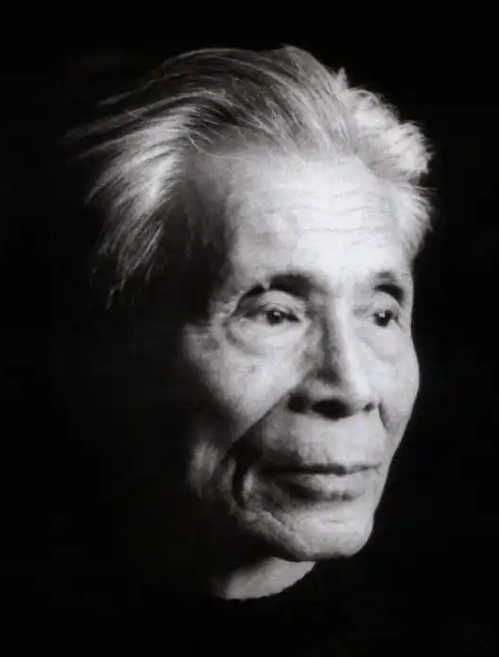Wu Guan Zhong
Wu Guanzhong (1919–2010), born in Yixing, Jiangsu Province, was a renowned contemporary painter, oil painter, and art educator. His representative oil paintings include "Three Gorges of the Yangtze River," "Northern Landscape," "Birds' Paradise," "Pine Trees on Huangshan," and "Lu Xun's Hometown," among others. He also authored more than ten collections of essays, including "Wu Guanzhong on Art," "Selected Prose of Wu Guanzhong," and "The缘 of Beauty and Ugliness."
At 23:57 on June 25, 2010, Mr. Wu Guanzhong passed away at Beijing Hospital due to ineffective medical treatment, aged 91.
On April 4, 2016, Wu Guanzhong’s oil painting "Zhouzhuang" sold for HK$236 million, setting a new record for Chinese oil paintings at auction.
On June 2, 2019, Wu Guanzhong’s ink painting "Shizi Lin" was sold for over RMB 140 million.
丨Biography
During the 1950s–1970s, Wu Guanzhong devoted himself to landscape oil painting and explored the sinicization of oil painting. He endeavored to integrate the directness and vitality of European oil painting in depicting nature, along with its rich and subtle coloration, with the spiritual essence and aesthetic ideals of traditional Chinese art.
From the 1970s onward, Wu Guanzhong gradually began creating Chinese ink paintings as well. He sought to express modern spirit using traditional Chinese materials and tools, while exploring innovation in Chinese painting.
He was born on August 29, 1919 (lunar calendar: the fifth day of the leap seventh month) into a peasant family in Zhakou Township, Yixing County, Jiangsu Province.
In 1926, he enrolled at Wu Family Primary School.
In 1930, he entered Yixing County Eshan Primary School.
In 1931, after graduating from primary school, he was admitted to Wuxi Normal School.
In 1934, after completing three years of junior normal education, he enrolled in the Electrical Engineering Department of the Industrial School sponsored by Zhejiang University.
In 1935, he applied to the National Hangzhou Academy of Fine Arts.
In 1936, he entered the National Hangzhou Academy of Fine Arts, studying Western painting, while also learning Chinese painting and watercolor.
In 1937, with the outbreak of the War of Resistance Against Japan, President Lin Fengmian led the entire faculty and student body, together with the people, to evacuate Hangzhou.
In 1938, he graduated from the affiliated middle school of the art academy and entered the undergraduate program in oil painting under the tutelage of Chang Shuhong and Guan Liang, while continuing to study Chinese painting.
In 1940, he switched to Chinese painting and became a student of Pan Tianshou, copying many masterpieces from successive dynasties.
In 1941, still captivated by the colors of oil painting, he returned to the oil painting department.
In 1942, he graduated from the National Hangzhou Academy of Fine Arts.
In 1943, he held his first solo exhibition at the Youth Palace in Shapingba, Chongqing, Sichuan.
In 1946, he ranked first nationwide in the national scholarship examination for overseas study in painting.
In 1947, he enrolled at the École Nationale Supérieure des Beaux-Arts in Paris.
In 1948, his works were exhibited at the Paris Spring Salon and Autumn Salon.
In 1950, he returned to China and taught at the Central Academy of Fine Arts.
In 1953, he served as Associate Professor at the Department of Architecture, Tsinghua University.
In 1956, he taught at the Beijing Institute of Arts.
In 1964, he taught at the Central Academy of Arts and Design.
In 1970, during the Cultural Revolution, he was sent to rural Hebei for labor.
In 1973, he was recalled to Beijing to participate in mural painting projects for hotels.
In 1978, the Central Academy of Arts and Design hosted the "Exhibition of Wu Guanzhong’s Works."
In 1979, he was elected Standing Director of the China Artists Association.
In 1987, the Hong Kong Arts Centre hosted the "Wu Guanzhong Retrospective Exhibition."
In 1991, the French Ministry of Culture awarded him the highest honor of the French Order of Arts and Letters.
In 1992, the British Museum broke its tradition of exhibiting only ancient artifacts by holding the first-ever exhibition for a living Chinese artist: "Wu Guanzhong: A Chinese Painter of the Twentieth Century." The museum also solemnly acquired Wu’s large-scale ink-and-color masterpiece "Birds’ Paradise."
In 1993, the Musée Cernuschi in Paris held the exhibition "Toward the World: Wu Guanzhong — Oil Paintings, Ink Washes, and Sketches," and presented him with the "Gold Medal of the City of Paris."
In 1994, he was elected Standing Committee Member of the National Committee of the Chinese People's Political Consultative Conference.
In 1999, the Ministry of Culture of the People’s Republic of China hosted the "Exhibition of Wu Guanzhong’s Works."
In 2000, he was elected Corresponding Member of the Académie des Beaux-Arts of the Institut de France, becoming the first Chinese artist ever to receive this honor—and the first Asian in nearly two centuries since the founding of the Académie.
On December 26, 2006, The Chinese University of Hong Kong conferred upon Wu Guanzhong the honorary degree of Doctor of Literature.
In August 2007, Hunan Fine Arts Publishing House published "Complete Collection of Wu Guanzhong."
At 23:57 on June 25, 2010, Mr. Wu Guanzhong passed away at Beijing Hospital due to ineffective medical treatment, aged 91.

 中文
中文  en
en 
